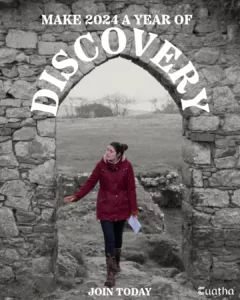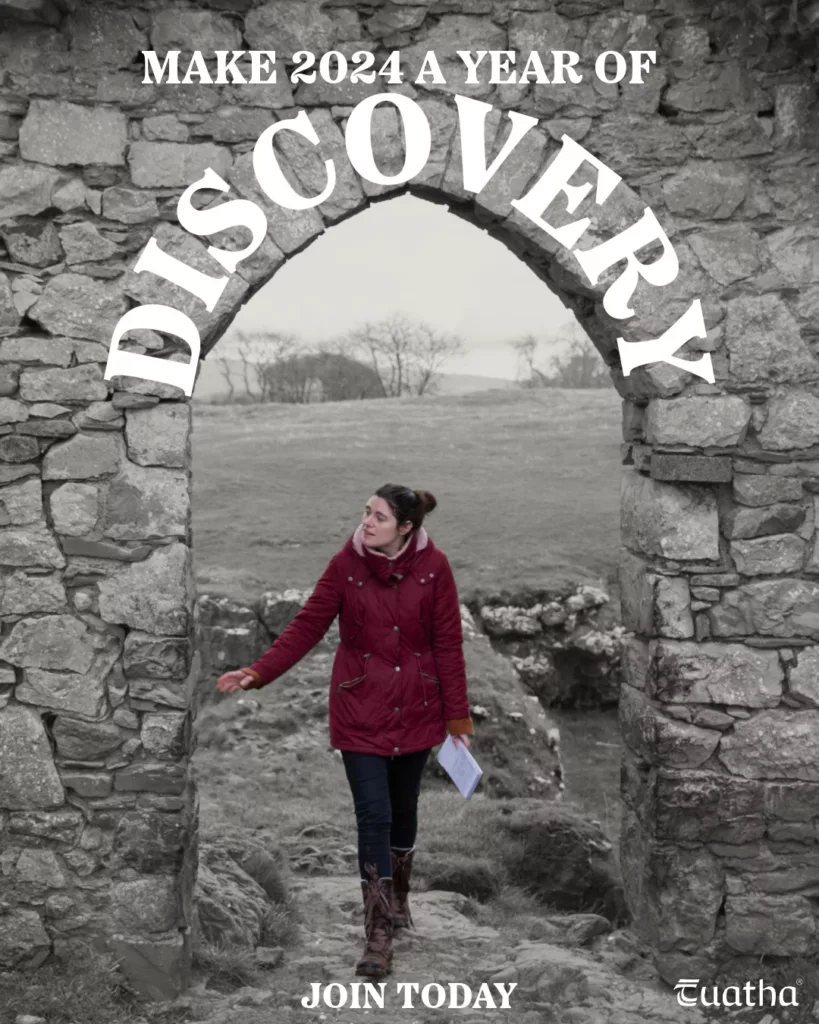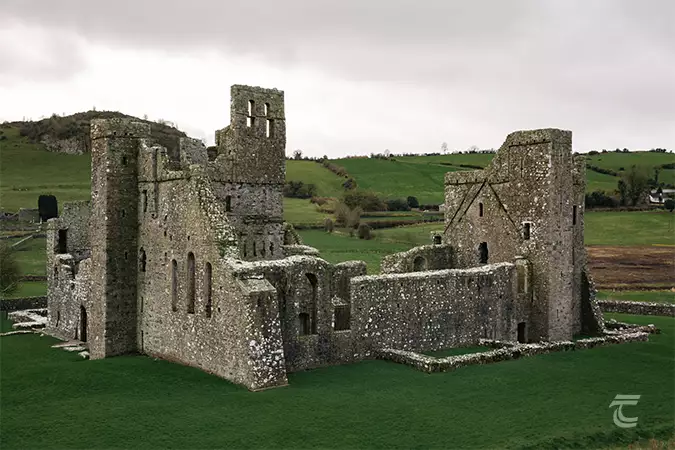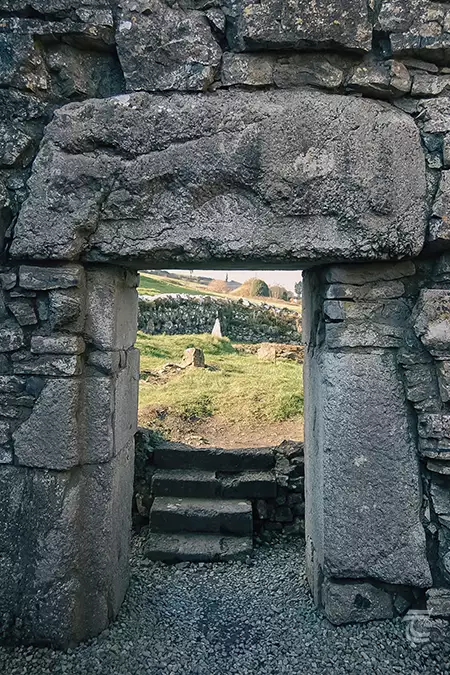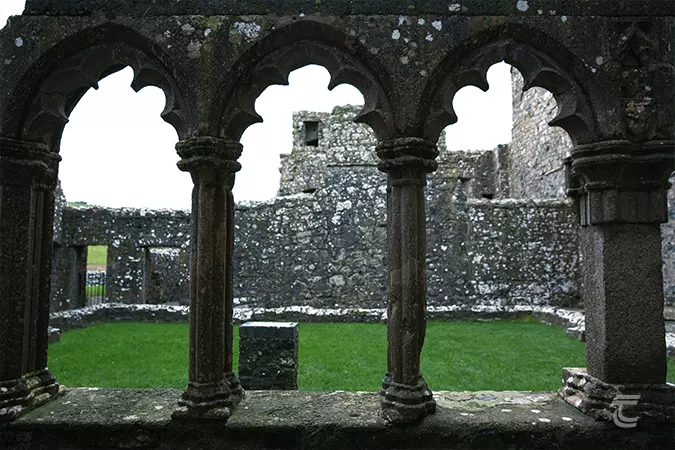Fore Abbey
Located in the small village of Fore in rural Westmeath, Fore Abbey is a wonderful example of a medieval monastic complex that spans across centuries. The first foundation is believed to have been established by St. Féichín in around AD 630, and the small monastery quickly grew in size and importance, receiving many mentions in the Annals of Ireland. The main patrons of the early foundation may have been the Caille Follamain, one of the three main branches of the powerful Southern Uí Néill. St. Féichín died in AD 665 at Fore, having caught the dreaded Yellow Plague.
Although there are no visible remains of this initial 7th-century monastery (indeed, the exact location of the earliest foundation has still not been conclusively proven) there is St. Féichin’s Church located on the slopes directly above the main part of Fore Abbey (for more information see below the gallery). The huge lintel above the doorway is said to be one of the Seven Wonders of Fore: “The Monastery Built upon the Bog/ The Mill Without a Race/ The Water that Flows Uphill/ The Tree that Won’t Burn/ The Water that Doesn’t Boil/ The Anchorite in a Stone/ The Lintel Stone Raised by St. Féichin’s Prayers“.
Most of the structures that form the main part of Fore Abbey date to the period following the Norman invasion of Ireland. The de Lacys ruled the Lordship of Meath (which, roughly speaking, incorporated today’s Meath and Westmeath) from their fortress at Trim Castle. De Lacy would have appreciated the value of the monastery and the population growing around it. He had a priory established in around 1180. It was founded as a dependency of the Abbey of St. Taurin at Evreux in Normandy, France, and is one of the only substantial remains of an Anglo-Norman Benedictine House in Ireland. The Benedictine movement was extremely popular across Europe, but the main orders in Ireland tended to be Augustinians, Cistercians and Franciscans.
Fore Abbey was constructed around a central cloister, with a church to the north, the dormitory for the monks to the east, the refectory to the south with its adjacent kitchen to the south-west. Interestingly, archaeological excavations carried out by Georgina Scally in 1992 seem to suggest the truth of another of Fore’s seven wonders – the excavations revealed that the abbey was indeed built on a bog! The foundations of the gatehouse were found to have been constructed upon a half-metre depth of peat. Two parallel lines of a post and wattle fence were exposed built directly upon the bog, and enclosed an area of rough gravel and stones, which was interpreted as a pathway over the obviously difficult terrain.
By the 15th century Fore Abbey had become vulnerable to raids from powerful Irish families like the O’Reillys and the O’Farrells, as it was situated outside of the area known as The Pale. It was attacked in 1423 and 1428, and remained vulnerable enough that gates and walls were built to surround the monastic settlement. Despite these raids Fore Abbey was still a wealthy place and new towers and a revamped cloister area were added in the 15th century.
A number of wayside crosses and penitential stations are located in the landscape around Fore, evidence that the site continued to be an important place of pilgrimage long after its initial foundation. Today, Fore Abbey is steeped in history and its stunning ruins can easily occupy an afternoon’s wandering about.
For practical information about visiting this site Click Here
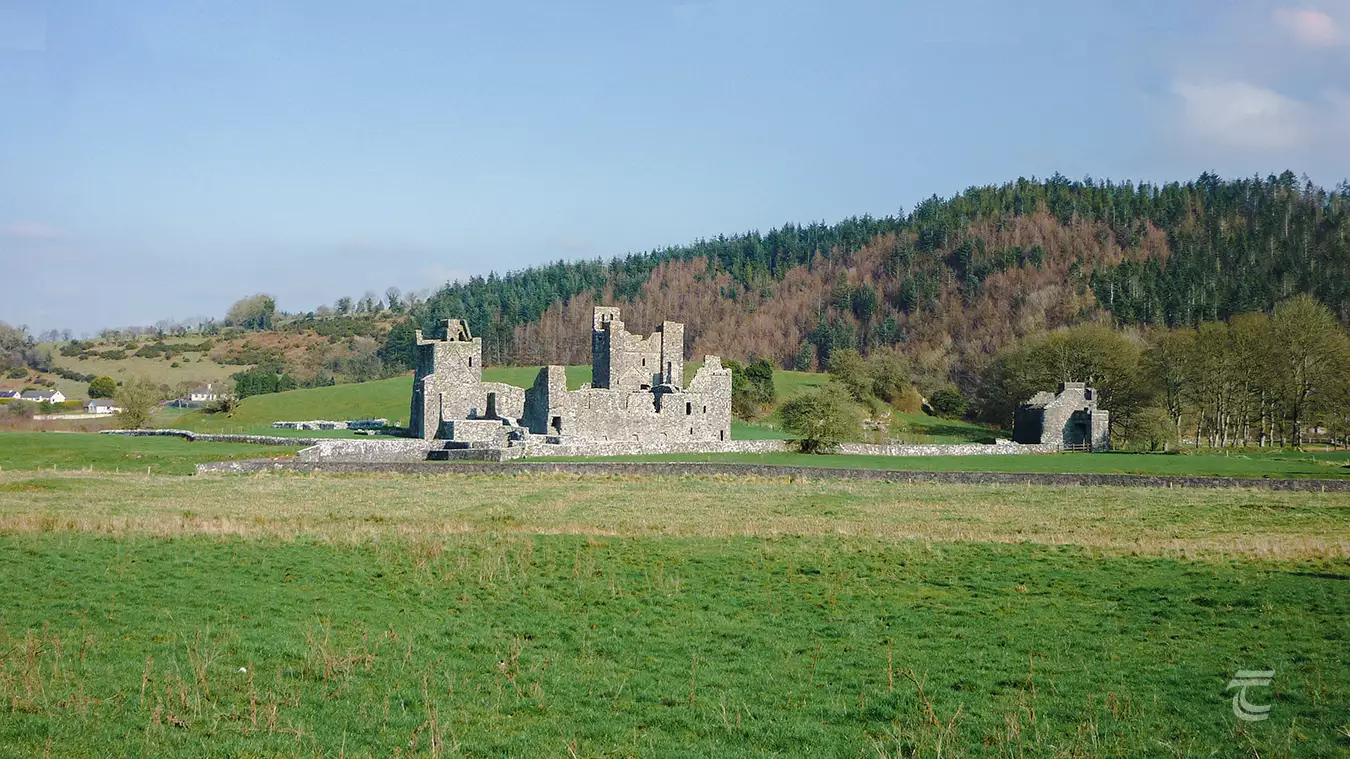
Fore Abbey • Westmeath
St. Féichín’s Church

St. Féichín’s Church • Fore Abbey
The main part of this church probably dates to at least as early as the 10th century, with a later chancel added in the 13th century to extend the church. It is constructed from coursed limestone masonry. The enormous cross-inscribed lintel is said to have been miraculously lifted into position by St. Féichin himself as one of the Seven Wonders of Fore. Although the early Irish monastic site was replaced by the Benedictine abbey, St. Féichin’s Church continued in use as parish church well into the medieval period.

St. Féichín’s Church • Fore Abbey
Anchorite’s Cell
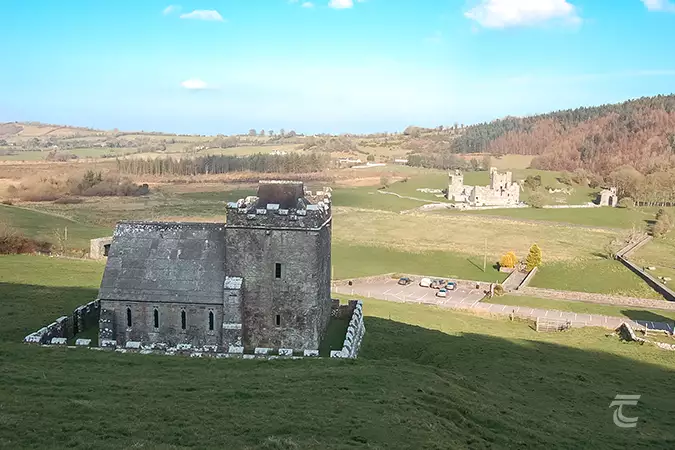
Anchorite’s Cell • Fore Abbey
The remains here consist of a late 15th/16th century tower house with a 19th century mausoleum of the Nugent family, built in the style of a church, at its western end. A rectangular sandstone plaque above the Nugent mausoleum door in the Anchorite’s Church notes that a castle (the tower house) and chapel as having been rebuilt in 1680. The plaque bears the Nugent arms and a relief inscription: THE RIGHT HONORABLE/ RICHARD NVGENT EARLE/ OF WESTMEATHE AT HIS OWN/ EXPENCES REBVILDED THIS/ CHAPLE AND CASTLE FOR/ THE BVRYINGE PLACE AND/ PIOVS VSE OF HIMSELFE AND/ HIS SVCESSORS ANNO/ DOMINI 1680.
Tobernacogany Holy Well
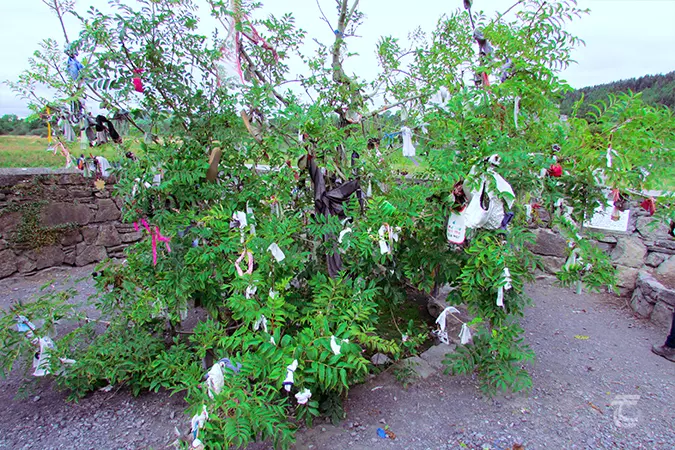
Tobernacogany Holy Well • Fore Abbey
The small holy well features in another of the Seven Wonders of Fore with the ‘water that never boils’. The water is said to have curative properties, being particularly good for headaches and toothache. The ash tree growing from the well is festooned with rags left by pilgrims. This is a relatively young tree, that replaced one known as the ‘money tree’, with wood that miraculously never burned. An old tradition saw people hammering coins into the bark of the tree, eventually poisoning it.

Tobernacogany Holy Well • Fore Abbey
St. Féichin’s Mill

St. Féichin’s Mill • Fore Abbey
This ruin of a stone building is thought to stand on the site of an early medieval mill. The mill pond has long since silted up, but the springs still create small streams that pass through the ruins of the mill site. This is also one of the Seven Wonders of Fore – that Féichin managed to establish a mill here where there was no water, until he blessed the land and called it forth. I was fortunate enough to excavate an early mill at Kilbegly in Roscommon which was similarly fed by springs rather than a stream, so Féichin may have just been an excellent hydrological engineer rather than a miracle worker!
The Benedictine Abbey of Saints Féichin and Taurin
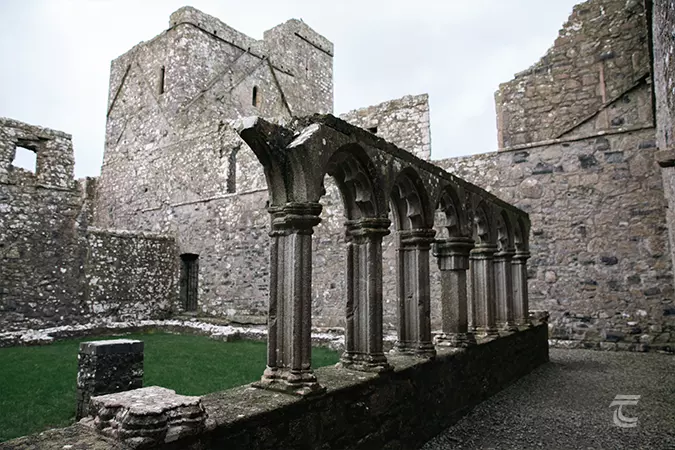
The Benedictine Abbey of Saints Féichin and Taurin • Fore Abbey
The extensive ruins of this large medieval abbey are Ireland’s best surviving example of a Benedictine Foundation. The main patron of the abbey was Walter de Lacy, the powerful Lord of Meath. It was constructed around a central cloister, with a church to the north, the dormitory for the monks to the east, the refectory to the south with its adjacent kitchen to the south-west. You can also see the remains of a dovecote behind the main buildings, the pigeons used to supply the monastery with protein and their droppings were prized as fertiliser.

The Benedictine Abbey of Saints Féichin and Taurin • Fore Abbey
The Gatehouse
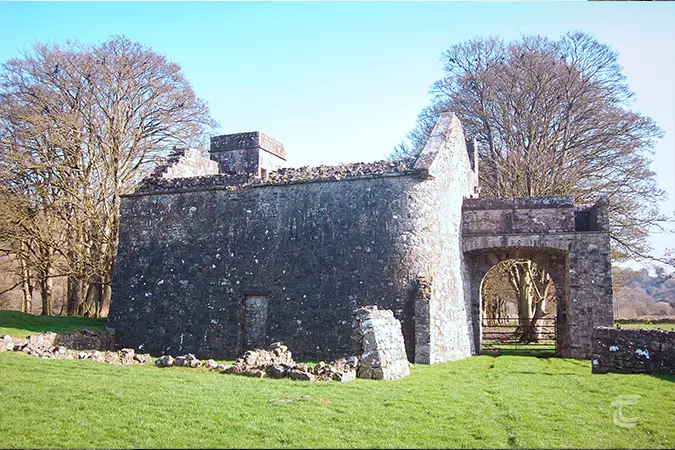
The Gatehouse • Fore Abbey
The gatehouse dates to the 13th century and it once guarded the causewayed entrance over the enclosing moat that once protected the abbey. It was once two-storied, and it is likely that the guards of the monastery lived in this building, as fireplaces are evident. In 1815 a painting of the abbey depicts the gatehouse in a fairly ruined and dilapidated state. It is known to have been reconstructed in c.1850 when a substantial stone porch was added to the front of the building and a doorway knocked through the blocked up 13th-century archway.
Upper left: the Benedictine Abbey • Lower left: the medieval cloister • Right: a large lintel in St Féichin’s Church, one of the Seven Wonders
Top: the Benedictine Abbey • Middle: a large lintel in St Féichin’s Church, one of the Seven Wonders • Bottom: the medieval cloister
Fore Abbey Visitor Information
St. Féichin’s Fore Abbey is said to contain ‘Seven Wonders’, and it certainly still offers many wonders to explore, including a 10th century church, a holy well, and Ireland’s best surviving example of a Benedictine Foundation.
Explore more sites in Ireland’s Hidden Heartlands
